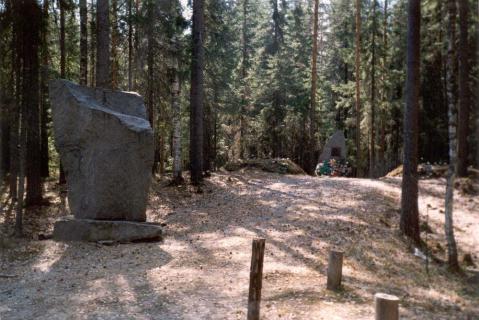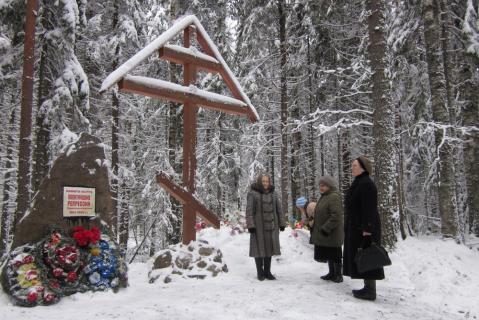The burials of the executed were discovered as a result of exploratory work in the pine forests around the town of Pudozh in May 1989. The location of the killing field (Chernaya rechka) was determined from the tales of local inhabitants who in the late 1930s found the hats of those shot in the forest. Over an area of roughly 3 hectares no less than seven burial pits were discovered. When one was excavated 25 skulls with bullet holes, fragments of skeletons and personal belongings were found.
The investigation conducted by the Karelian Republic Prosecutor’s Office concluded that “in the late 1930s and early 1940s NKVD officers systematically executed individuals at Chernaya rechka who were arrested for crimes committed under Article 58 (1926 Criminal Code). The majority of those shot were inhabitants of the Pudozh district, individuals of Finnish nationality and condemned prisoners from Belbaltlag.” The first group of 12 prisoners from Pudozh Prison were shot on 5 August 1937 in accordance with NKVD order No. 00447 (30 July 1937) which marks the beginning of the Great Terror in Karelia. Local historian Ye.G. Nilov who led the exploratory work believes that no less than 350 people were shot at that location. Executions took place elsewhere at sites that have not yet been discovered. Execution lists for the Pudozh district based on information from the Karelian KGB archives were published in part in the Pudozh Vestnik newspaper. Later they were included in full in The Commemorative Lists of Karelia (2002).
On 14 October 1989 the exhumed remains were reburied where they were found. A post bearing an inscription was placed nearby (“Victims of NKVD-KGB repression in 1937-1938 lie buried here”) with two stones indicating the common graves. That day a granite pillar was placed among the grave mounds, the first memorial to the victims of political repression in Karelia: “In memory of the victims of repression in the Pudozh district in the 1930s and 1940s”.
In 1998, the Karelian government declared the memorial area a site of cultural heritage (of regional significance). The Pudozh district museum conducts tours which include a visit to the memorial.
The online Memorial database (2025) lists 13,408 victims in Karelia. (See Petrozavodsk.)
11,317 were shot. 1,998 were sent to a variety of camps where 424 died (Sevvostlag, Unzhlag, Pechorlag and Taishetlag).
The version of the lists at the Russian National Library (“Their Names Restored”) contains entries for 376 shot at and around Pudozh.
| Date | Nature of ceremonies | Organiser or responsible person | Participants | Frequency |
|---|---|---|---|---|
|
30 October
|
Remembrance Day for the Victims of Political Repression
|
Pudozh municipal district
|
nk
|
Annual event
|
| State of burials | Area | Boundaries |
|---|---|---|
|
Topsoil subsidence over burials, no less than 7 burial mounds
|
About 3 hectares
|
Not delineated
|
[ original texts and hyperlinks ]
“Memory”, Pudozhsky uezd, 24 October 2013
“Pudozh. Execution and burial site”, Virtual Museum of the Gulag [retrieved on 26 May 2022; no longer accessible]
“Executions in Karelia (1937-1938)” Dmitriev Affair website (accessed 16 Dec 2025) {in English}
*
Reply by the Pudozh municipal district administration, № 2088 of 29 April 2014, to a formal enquiry by RIC Memorial (St Petersburg)
Reply by the Karelian Republic’s Ministry of Culture (№ 1815/11-1-15 of 5 May 2014) to a formal enquiry by RIC Memorial (St Petersburg)



